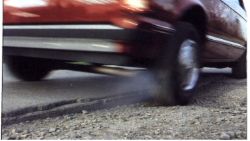That saves me. Thanks for being so sesnbile!
Killer roads: let's look closer
By: Lawrence P. Lonero
Date: Thursday, 15. May 2008
Larry Lonero is an expert on crash causes and a principal of Northport Associates, a consulting company based in Ontario, Canada.
As we were traveling to Detroit on assignment anyway, Dan, the editor-in-chief of Drivers.com, asked us to form an opinion as to whether there is anything obviously wrong with Ontario's 401 Highway between London and Chatham, in Canada. After a dozen serious crashes in the past few months, the news media say casualties are suddenly so numerous that there must be something wrong with the road in that area.
The new Minister of Transportation says he is going to get to the bottom of the dozen, but we haven't yet heard how many crashes we should expect on this piece of road. In the past, the police, news media, and the Ministry have not shown a strong understanding of random statistical variation, and we suspect they may be up against one now.
From my past life as a provincial safety research bureaucrat, I recall a particularly funny/sad example of how this can work. Without asking anybody who knew the data, the MTO PR department noticed a big jump in quarterly fatalities from the same quarter the year before, the usual kind of non-sense data reporting that the media use to sell papers and keep us in ignorance. The Ministry put out all kinds of news releases and even started some sort of investigation and new program development to stop this obvious rush to destruction. The reality, however, was that the notorious past quarter was not so bad; actually, the second-best quarter in over ten years. The same quarter the year before, of course, was the very best quarter, probably as a result of such bad weather that almost nobody in the province could get going fast enough to get killed (this was, of course, before we all had 4x4s and could get killed in any weather). Once shown the longer trend, the Ministry quietly put away "getting to the bottom" of this outrage. It might have been useful to try to find out why so few people got killed in that quarter, but it is always hard for the government and media to get excited about good-news stuff like that.
Anyway, the once-again notorious piece of 401 west of London to Chatham is a poor, sad old piece of freeway, with soft shoulders, a narrow grass median and a lot of tired, broken surface. It's not a lot different from many other older stretches in the province, designed before anybody really knew how to do it right. Except for a rough, broken surface and a lot more traffic, it's not much worse than it ever was. Maybe, however, crashes are "migrating" down to these poor, old sections. Other parts of Ontario's freeway system have been upgraded and become harder to crash on.
If there is anything unique about this piece of road, it is probably that so much of it is "dead" straight, which is not a good thing in freeway design. At the time it was laid out, straight may have seemed good, since it is cheaper to build, and the flat terrain in the area makes it possible to build straight.
 A
typical fatal crash on this type of road involves a car dropping off the pavement
onto the right shoulder and then swerving back, overshooting to the left and
going across both the pavement and the narrow, unguarded median into opposite-direction
traffic. Much of the opposing traffic consists of speeding semi trucks, which
have great momentum and limited crash evasion capability. This stretch of 401
does not have the narrowest median, which honor goes to the older stretch between
Tilbury and Windsor. The current state of the London-Chatham section resembles
what has just been replaced down in my neighborhood in eastern Ontario, where
the 401 now has wider pavement and a continuous concrete median barrier.
A
typical fatal crash on this type of road involves a car dropping off the pavement
onto the right shoulder and then swerving back, overshooting to the left and
going across both the pavement and the narrow, unguarded median into opposite-direction
traffic. Much of the opposing traffic consists of speeding semi trucks, which
have great momentum and limited crash evasion capability. This stretch of 401
does not have the narrowest median, which honor goes to the older stretch between
Tilbury and Windsor. The current state of the London-Chatham section resembles
what has just been replaced down in my neighborhood in eastern Ontario, where
the 401 now has wider pavement and a continuous concrete median barrier.
To get the money to quickly bring the road section in question up to a modern standard probably requires a certain amount of manipulation of the media and public opinion. So maybe it does not matter whether a cluster of tragic crashes is a "real" problem or a random statistical "error." If it helps get the road fixed, great.
However, if they raise the priority on renovation of the London-Chatham section, does this mean that some other piece of road, which is now planned for upgrading, gets put off, until it has its own random cluster of a dozen deaths? Could we hope that bureaucrats and politicians might have sufficient vision to keep the system up to a high standard without waiting for a dozen unnecessary deaths?
Further comments to this article have been disabled.
All Comments (2)
Showing 1 - 2 comments
![]() Kaeden,
Kaeden,
![]() janerr,
janerr,
if its the highway why not fix the problem now????????????????????????????????????????????????????????????????????????
